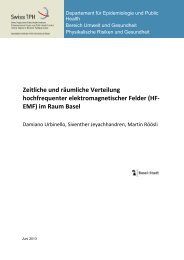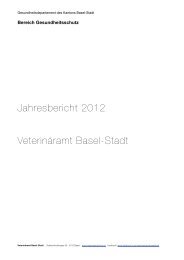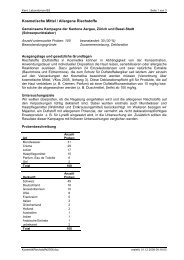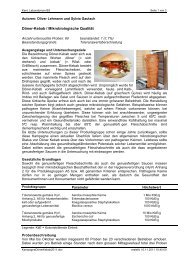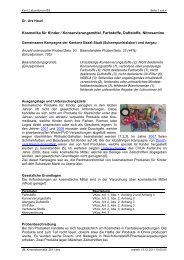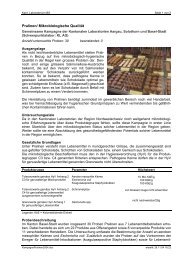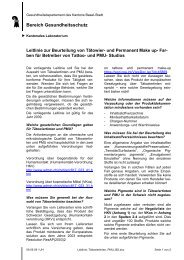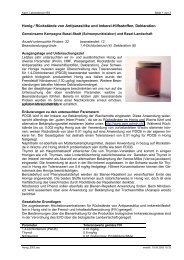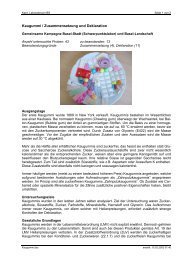Bericht als PDF herunterladen
Bericht als PDF herunterladen
Bericht als PDF herunterladen
Create successful ePaper yourself
Turn your PDF publications into a flip-book with our unique Google optimized e-Paper software.
Kant. Laboratorium BS Page 1 of 4<br />
Finger paints / preservatives, primary aromatic amines, bittering agents,<br />
colourants and declaration<br />
Customs campaign by the Federal Office of Public Health (BAG) (6 sets and 30 individual<br />
samples) – measurements by Basel-City (specialist laboratory) and Vaud (colourants)<br />
Further samples from the Cantons of Aargau (3 / 16) and Basel-City (5 / 26)<br />
Number of sets investigated: 14<br />
(72 individual samples):<br />
Grounds for objection:<br />
Sets objected to: 13 (93%)<br />
Excessive amounts of preservative (3); no bittering<br />
agent (7); no declaration of bittering agent and/or<br />
preservative (8); no warning notices (2); warning notice<br />
not present in all official languages (5)<br />
Background<br />
Finger paints are mainly used by pre-school children.<br />
During use, considerable skin surface area comes into<br />
contact with the paint. There is <strong>als</strong>o the possibility that<br />
children will lick their fingers and therefore swallow fairly<br />
large quantities of the paints.<br />
For these reasons, finger paints were the first toys for<br />
which the use of organic chemical compounds was<br />
regulated. The European Standard on Toy Safety – part<br />
7, finger paints – requirements and test methods (EN<br />
71/7, for short) came into force in 2002. It includes three<br />
positive lists, regulating preservatives, colourants and<br />
bittering agents permitted for use in finger paints. Furthermore, it specifies that finger paints<br />
must contain bittering agents to prevent children from licking their fingers. As many colourants<br />
and pigments may contain toxic aromatic amines, limit values are established for the most<br />
critical of these substances. Concrete warning notices are <strong>als</strong>o prescribed. In general, all<br />
information should be present in the relevant national language.<br />
Following a transitional period in which manufacturers were allowed time to adapt their products<br />
to the standard, an inspection of this product category was considered necessary in 2005.<br />
Aims of the investigation<br />
The aim of the investigation was a broad inspection of the Swiss market for compliance of the<br />
most important parameters with EN 71/7. This was achieved through a customs inspection<br />
programme led by the BAG. Further samples were collected in the Cantons of Basel-City and<br />
Aargau.<br />
Preservatives, bittering agents and aromatic amines, present either as impurities or due to<br />
reductive cleavage of the colourants were investigated by the state laboratory of Basel-City.<br />
Colourants were investigated by the state laboratory of the Canton of Vaud (KLVD).<br />
Furthermore, the required warning notices were checked, although in the case of customs<br />
samples these can theoretically be added by the Swiss importer at a later stage.<br />
Statutory basis<br />
Parameter<br />
Assessment<br />
Warning notice EN 71/7, 6.2.2<br />
Warning notice in three official languages EN 71/7, 6.1<br />
Declaration of preservative and bittering agent EN 71/7, 6.2.2<br />
Preservatives<br />
EN 71/7, 4.3 and appendix B<br />
Bittering agents EN 71/7, 4.6<br />
Colouring agents<br />
EN 71/7, 4.2.2. and appendix A<br />
Aromatic amines – impurities EN 71/7, 4.5<br />
Aromatic amines from reductive cleavage of azo-dyes EN 71/7, 4.2.3<br />
Report0602.doc compiled: 25.01.06 07:31:00
Kant. Laboratorium BS Page 2 of 4<br />
Sample description<br />
The samples were collected at customs (6 sets), and further samples were taken from stores in<br />
the Cantons of Aargau and Basel-City.<br />
Country of origin<br />
Number of sets<br />
(samples)<br />
Germany 7 (39)<br />
China 3 (14)<br />
Netherlands 2 (9)<br />
Malaysia 1 (8)<br />
France 1 (2)<br />
Total 14 (72)<br />
Test method<br />
Because of the broad scope of this investigation, a wide range of methods were used to test the<br />
finger paints:<br />
Parameter group<br />
Number of of which<br />
parameters permitted<br />
Methods<br />
UV-active preservatives 46 24 HPLC-DAD<br />
Isothiazolinones 3 2 HPLC-DAD<br />
Redox-active preservatives 3 3 HPLC-ECD<br />
Free formaldehyde 1 1 HPLC-DAD<br />
Quaternary ammonium compounds 15 8 HPTLC<br />
Iodopropynyl butylcarbamate (Screening) 1 1 HPLC-MS<br />
Bittering agents (Screening) 3 3 HPLC-MS<br />
Aromatic amines 33 - HPLC-MS<br />
Aromatic amines following reductive cleavage 29 - HPLC-MS<br />
Colouring agents (KLVD customs samples) approx. 100 - HPTLC and UV<br />
Results<br />
Preservatives<br />
• Three sets (19 paints) contained more than the permitted 15 mg/kg of methyl<br />
isothiazolinone/methylchloro isothiazolinone (MI/MCI). On the basis of the values found and<br />
the fact that particularly MCI is not stable, it can be concluded that the finger paints were<br />
originally preserved with between 30 and 60 mg/kg depending on the set. MI/MCI is known to<br />
be a potent allergen. Allergies to MI/MCI are particularly problematic as several cosmetics,<br />
every-day chemic<strong>als</strong> (for example starch sprays for ironing), as well as colourants and<br />
varnish are preserved with MI/MCI.<br />
• Furthermore, the following preservatives were found (number of sets affected shown in<br />
brackets). All concentrations were within the legal requirements.<br />
Phenoxyethanol (2), methyl- (8), ethyl- (1), propyl- (6), and butyl- (2) paraben,<br />
4-hydroxybenzoic acid [as degradation product of the parabens (2)], sorbic acid (3), o-<br />
phenylphenol (5), bronopol (3), free formaldehyde (6). Formaldehyde is not usually used<br />
directly but is released by several different preservatives, such as bronopol, diazolidinyl urea<br />
and imidazolidinyl urea.<br />
• No non-permitted preservatives were detected.<br />
Bittering agents<br />
According to EN 71/7, finger paints need to contain denatonium benzoate, saccharose<br />
octaacetate, or naringin as a bittering agent. A bittering agent (denatonium benzoate) was only<br />
detected in 7 of the sets. However, the LC-MS method, with a limit of detection of approximately<br />
25 µg/g, does not cover the whole activity range specified by the standard for denatonium<br />
benzoate (up to 4 µg/g). The concentration of denatonium benzoate in samples was generally<br />
between 100 and 300 µg/g. In those cases where no bittering agent was detected, the<br />
manufacturers were asked. The answers indicated that none of the samples contained the<br />
required bittering agent.<br />
Report0602.doc compiled: 25.01.06 07:31:00
Kant. Laboratorium BS Page 3 of 4<br />
Colourants<br />
No non-permitted colourants or pigments were detected. Phthalocyanin pigments (C.I. 74160<br />
and 74260) were the most common colourants used to produce blue and green tones. Azo and<br />
quinoline colourants were most commonly used for yellow, orange and red colours – this colour<br />
group <strong>als</strong>o contained the majority of the 31 non-identified colourants and pigments.<br />
One sample contained Pigment Red 2, which is not on the positive list for finger paints. It is<br />
however covered by EN 71/7, 4.2.2, according to which all colourants which are not classified<br />
as being carcinogenic, mutagenic, teratogenic, very toxic, toxic, harmful to health, corrosive,<br />
irritant or sensitizing may, nevertheless, be used as colouring agents in finger paints.<br />
C.I. Number<br />
C.I. Level<br />
Number of<br />
samples<br />
C.I. 74160 Pigment Blue 15 13<br />
C.I. 74260 Pigment Green 7 10<br />
C.I. 47005 Acid Yellow 3 6<br />
C.I. 16255 Acid Red 18 4<br />
C.I. 42051 Acid Blue 3 4<br />
C.I. 11680 Pigment Yellow 1 3<br />
C.I. 21100 Pigment Yellow 13 3<br />
C.I. 11710 Pigment Yellow 3 1<br />
C.I. 12310 Pigment Red 2 1<br />
C.I. 77007 Pigment Blue 29 1<br />
C.I. 77268 Food Black 3 1<br />
Iron oxide 1<br />
Titanium dioxide 1<br />
not identified 31<br />
Total 80<br />
Aromatic amines as impurities or following reductive cleavage<br />
• The finger paints investigated did not contain detectable levels of carcinogenic primary<br />
aromatic amines according to 4.5. The tertiary aromatic amines Michler’s ketone, methane<br />
base and auramine O were likewise not detected.<br />
• In one sample, approx. 7 mg/kg o-toluidine following reductive cleavage with sodium<br />
hydrosulfite (according to EN 71/7). This was just under the limit value of 10 mg/kg, but<br />
indicates that o-toluidine is present as a pigment component. The red pigment itself could<br />
not be identified.<br />
Declaration<br />
Not for the first time, warning notices were not present in all three official languages (5 of 14),<br />
as required due to Switzerland being a trilingual country. It is however astonishing that so many<br />
products bearing the CE label do not conform to the requirements of European Standard 71/7<br />
regarding declaration and warning notices. The declaration of preservatives and bittering<br />
agents, required by the standard was absent in no less than 8 of 14 cases. In one case, only the<br />
trade name for the preservative, which will mean little to the consumer, was used. The warning<br />
notice “Caution! Children under 3 years must be supervised by an adult” was completely absent<br />
from two packs.<br />
Measures taken<br />
The Canton in which the importer is based is responsible for measures taken. Sale of samples<br />
containing MI/MCI in excess of the limit value was forbidden.<br />
Conclusions<br />
• The requirements for finger paints are clearly defined in a European standard. All samples<br />
carried the CE sign, thereby indicating their conformity with EN 71/7. Despite this, 12 of 14<br />
finger-paint sets failed to fulfil important aspects of this standard, casting the manufacturers<br />
and their accrediting agencies in a poor light. Indeed, analytical investigations had to be<br />
carried out in our laboratory to demonstrate the limit value exceedance and absence of<br />
bittering agents, whereas simple inspection of the formulations and packaging would have<br />
Report0602.doc compiled: 25.01.06 07:31:00
Kant. Laboratorium BS Page 4 of 4<br />
been adequate for the accrediting agencies to determine that the products did not conform to<br />
the standard.<br />
• The high objection rate, in a product category for which there are uniform requirements<br />
throughout Europe demonstrates yet again that official inspection of these products is<br />
essential. It is less surprising that finger paints have apparently not yet been investigated by<br />
any other European laboratory, since the analysis of non-food products is a secondary<br />
consideration.<br />
• Because of the poor results from this year, a repeat of the campaign in 2006 is planned.<br />
Report0602.doc compiled: 25.01.06 07:31:00



